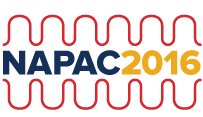Scope of Classifications
|
Main Classification 01 - Circular and Linear Colliders SPC Group leaders: M. Palmer (FNAL), F. Pilat (JLab – co-lead) |
||||||||||||||||||||||||||||||||||||||
|
Classification 1 is devoted to accelerators (synchrotrons, linacs, ERLs, etc.) providing colliding beams (hadrons and/or leptons) for particle physics experiments. It includes facilities colliding beams from different types of accelerators, such as linac-ring colliders. Among the subjects for this classification are operating experience and performance limitations, upgrade plans, accelerator physics and technology issues specific to colliders and the design and R&D for future projects. Sub-classifications associated with MC 01:
|
||||||||||||||||||||||||||||||||||||||
|
Main Classification 02 - Photon Sources and Electron Accelerators SPC Group leaders: A. Zholents (ANL), C. Steier (LBNL, co-lead) |
||||||||||||||||||||||||||||||||||||||
|
Classification 2 covers photon sources (synchrotron light sources, ERLs, FELs, laser systems, other free-electron sources such as THz sources, Compton sources, etc) and electron accelerators (linear, circular, recirculating, etc.). It includes insertion devices such as planar and helical field undulators. Associated accelerator systems, such as injectors, booster synchrotrons, photon beam lines and photon beam line components can also be proposed for this Session. Papers presented can be project descriptions or cover individual aspects of photon sources and electron accelerators. Both theoretical and experimental results are solicited. Sub-classifications associated with MC02:
|
||||||||||||||||||||||||||||||||||||||
|
Main Classification 03 – Advanced Acceleration Techniques and Alternative Particle Sources SPC Group leaders: M. Hogan (SLAC), P. Muggli (MPI, co-lead) |
||||||||||||||||||||||||||||||||||||||
|
Classification 3 is devoted to (i) new concepts of accelerating techniques which may overcome the present limitations of size and/or cost or which give access to very new beam characteristics, and (ii) novel and unconventional sources of particles, including electrons and protons, neutrons, ions, and secondary particles and antiparticles. Sub-classifications associated with MC03:
|
||||||||||||||||||||||||||||||||||||||
|
Main Classification 04 - Hadron Accelerators SPC leaders: J. Galambos (ORNL), M. Bai (COSY, co-lead) |
||||||||||||||||||||||||||||||||||||||
|
Classification 4 is devoted to designing, developing, upgrading, constructing and commissioning low-, medium- and high-energy hadron accelerators, excluding hadron colliders. The session includes ion sources, electrostatic accelerators, proton and ion linear accelerators, proton and ion synchrotrons, radioactive beam facilities, antiproton accumulators and collectors, ion accumulator and storage rings, cyclotrons, synchrocyclotrons, FFAGs and any other similar machines. Both low- and high-intensity machines are covered, as are all relevant aspects of high-intensity fixed-target accelerators such as proton drivers for spallation neutron sources, neutrino factories, etc. Sub-classifications associated with MC 04:
|
||||||||||||||||||||||||||||||||||||||
|
Main Classification 05 - Beam Dynamics and EM Fields SPC leaders: M. Blaskiewicz (BNL), J. Wurtele (Berkeley, co-lead) |
||||||||||||||||||||||||||||||||||||||
|
Classification 5 includes reviews and progress reports on general aspects of electro-magnetic interaction of charged particle beams in accelerators and storage rings. It covers linear and non-linear beam optics, modeling of externally applied or beam-generated electro-magnetic fields, as well as theory, observations and simulations of single-particle dynamics and collective effects, both coherent and incoherent. The emphasis is on deepening the understanding of fundamental processes or limitations governing beam dynamics and uncovering possible new mechanisms relevant to accelerator design and performance, independent of technological or project-specific aspects. Sub-classifications associated with MC 05:
|
||||||||||||||||||||||||||||||||||||||
|
Main Classification 06 – Accelerator Systems: Beam Instrumentation, Controls, Feedback and Operational Aspects SPC leaders: J. Byrd (LBNL), M. Minty (BNL, co-lead) |
||||||||||||||||||||||||||||||||||||||
|
Classification 6 is devoted to measurement and control of the beam properties in particle accelerators including beam diagnostics and instrumentation, beam feedback systems, low-level rf controls, timing and synchronization schemes and laser-based instrumentation. Included also are contributions on accelerator control systems, online modeling and applications control software, as well as operational aspects of modern accelerators such as alignment and surveying methods, machine protection systems, radiation protection and monitoring and issues pertaining to reliability and operability. Sub-classifications associated with MC 06:
|
||||||||||||||||||||||||||||||||||||||
|
Main Classification 07 - Accelerator Technology Main Systems SPC leaders: G. Apollinari (FNAL), J. Delayen (ODU/JLab, co-lead) |
||||||||||||||||||||||||||||||||||||||
|
Classification 7 is devoted to contributions on the design, construction, testing and performance of accelerator components or subsystems, with emphasis on technological aspects and methods. Special attention is due to technological developments that allow to improve accelerators from the point of view of performance, size or cost effectiveness. Contributions with a strong beam performance aspect should generally be classified elsewhere. Sub-classifications associated with MC 07:
|
||||||||||||||||||||||||||||||||||||||
|
Main Classification 08 - Applications of Accelerators, Technology Transfer and Industrial Relations SPC leaders: P. Ostroumov (ANL), S. Biedron (Colorado, co-lead) |
||||||||||||||||||||||||||||||||||||||
|
Classification 8 includes contributions with emphasis on the broad applications of accelerators, aspects of technology transfer and laboratory-industry relationships rather than on the specific accelerator technologies themselves. Technology Transfer contributions should seek to improve Accelerator Laboratory technology transfer (TT) methods and strategies, and the methodology for the creation of TT business opportunities by Industry. Covered topics include relevant issues for successful TT, structures needed to promote TT, incubator opportunities for start-up companies, and intellectual property and patenting issues. The Session for Industry is intended to address both sides of the relationship in order to improve technology transfer, contractual performance and the achievement of goals through the creation of mutual understanding, evolution of contractual mechanics, performance of joint research and development, and development of measures to optimize contract goals. Sub-classifications associated with MC08:
|
